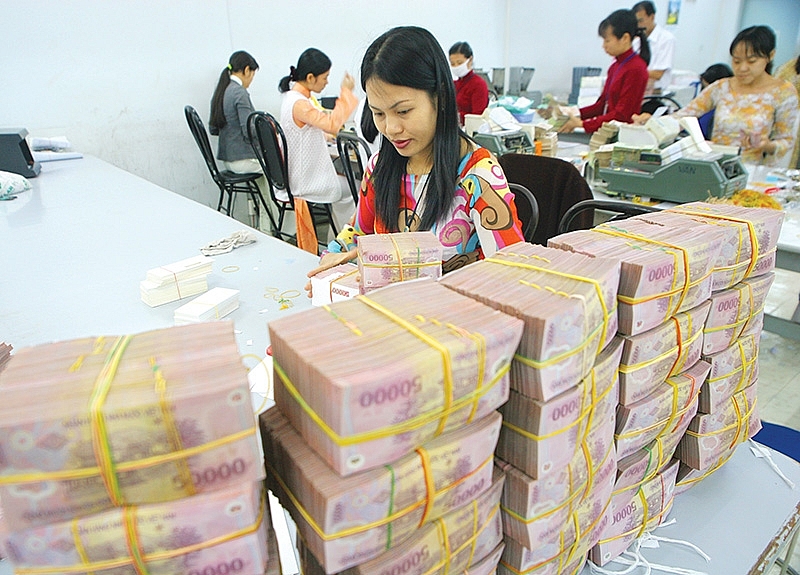Vietnam steady but external risks weigh
 |
| In any case, public debt will not hit the limit of 65 per cent of GDP, said the Ministry of Finance |
Vietnam’s real GDP grew 5.03 per cent on-year in the first quarter of 2022, extending the 5.22 per cent pace in the last quarter of 2021 as the services sector rebounded after more parts of its economy were reopened with the relaxation of mobility and distance restrictions.
The manufacturing sector continued to take the lead, and most significantly, the overall services sector expanded 4.58 per cent on-year, from 1.22 per cent in the previous quarter and 3.62 per cent in the first quarter of last year.
It was clear that service activities were able to benefit from the lifting of COVID-19 restrictions imposed during the second half of last year.
Recent data suggests that Vietnam’s underlying growth momentum remained intact in the second quarter of this year.
The manufacturing sector continued to power on, registering a 9.24 per cent on-year gain in the first five months, from 8.28 per cent in the first four months, and a strong performance of 12.59 in May 2021. This performance is also reflected in the purchasing managers’ index.
A forward indicator, foreign direct investment (FDI) inflows, pared back somewhat in May amid uncertainty from the Russia-Ukraine conflict and elevated commodities prices.
Registered FDI recorded a decline of 16.3 per cent on-year to $11.71 billion, the fourth straight month of negative readings. The high base from the strong inflow of registered FDI in 2021 at $31.15 billion also resulted in subdued readings so far.
On the consumer side, lifting domestic COVID-19 restrictions and reopening cross-border travel have injected new vigour into the services sector. Overall retail trade accelerated 9.69 per cent on-year in May, from 6.54 per cent in April, and well ahead of the 3 per cent drop in 2021, led by travel services (up 34.7 per cent), and accommodation and catering (15.75 per cent rise).
It is expected that tourism-dependent sectors such as accommodation and food will return to growth in the second quarter of 2022 after nine straight quarters of declines.
With the latest data as well as the headwinds ahead, the United Overseas Bank (UOB) keeps the 2022 GDP growth forecast for Vietnam at 6.5 per cent, in line with the official projection of 6.0- 6.5 per cent.
UOB's forecast assumes GDP growth in the second quarter of 2022 to pick up its pace to 6 per cent on-year, and then further to 7.6 per cent in the next quarter.
However, UOB also highlights several external risks that are posing challenges to this outlook: (1) the Russia-Ukraine conflict and its impact on commodity prices (and the resulting inflation risks on domestic and external demand), (2) global supply chain disruptions, (3) policy tightening globally, and (4) COVID-19 risks.
After touching the lowest in nearly a year at 1.4 per cent on-year in February, inflation in Vietnam has been trending up since to 2.86 per cent in May, which is still below the State Bank of Vietnam’s target of 4 per cent.
Elevated prices of global energy and food, as well as supply chain disruptions, have contributed to the jump in Vietnam’s inflation. Particularly, transport-related costs have been rising at a double-digit on-year pace in the past 14 months.
As Vietnam is able to supply foodstuffs domestically, the upside pressure on prices is largely dominated by the transport-related components of the consumer price basket, accounting for about 3/4 of the inflation thus far, compared to an average of 50 per cent in 2021.
With the Russia-Ukraine conflict stretching beyond 100 days and showing no signs of easing tensions and sanctions, it can be expected that Vietnam’s headline inflation rate will be at 3.7 per cent in 2022 and further rise to 5 per cent in 2023.
In the view of UOB experts, the VND is not spared from the Asia-wide weakness inflicted by the aggressive repricing in FED rate hike expectations and concerns of a deeper China slowdown.
The ratio of USD/VND rose by 1.7 per cent in the second quarter of 2022 to VND23,215, the highest level since August 2020. Cushioned by a strong growth outlook and domestic inflation remaining under control, the VND weakness is modest when compared to the Asia Dollar Index which fell over 4 per cent in the quarter.
What the stars mean:
★ Poor ★ ★ Promising ★★★ Good ★★★★ Very good ★★★★★ Exceptional
 Tag:
Tag:
Related Contents
Latest News
More News
- Ho Chi Minh City hits $8.37 billion in FDI (December 29, 2025 | 08:28)
- Tax sector wraps up 2025 and sets priorities for next year (December 25, 2025 | 14:00)
- Heavy industries set for pilot greenhouse gas quotas (December 25, 2025 | 10:00)
- $250 million deal targets women-owned SMEs, sustainable agriculture (December 22, 2025 | 17:40)
- UOB sees Vietnam growth easing in fourth quarter (December 22, 2025 | 17:39)
- Government moves to establish International Financial Centre (December 21, 2025 | 21:00)
- Vietnam's IFC to target global investment flows (December 21, 2025 | 18:00)
- Ha Tinh breaks ground on major Vingroup industrial and energy projects (December 19, 2025 | 18:24)
- EVN launches major power infrastructure projects nationwide (December 19, 2025 | 18:17)
- VAL inaugurates second production line to meet domestic animal feed demand (December 19, 2025 | 16:37)




























 Mobile Version
Mobile Version